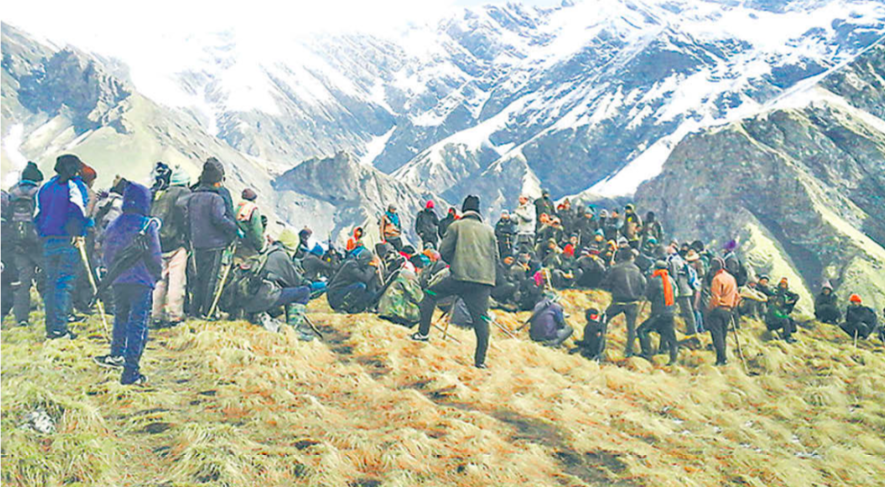National
Covid-19 could even put a halt to this year’s yarsa harvest
Every summer, before the monsoon arrives, thousands of individuals gather in high altitude pastures to collect the lucrative caterpillar fungus.
Sangam Prasain
If everything had gone to plan, a month from now, Shiva Bohara of Thuli Bheri Municipality would have been out on the hills of Dolpo, combing the slopes for yarsagumba. But this year, like everything else, the Covid-19 pandemic has even shut down collection of the lucrative caterpillar fungus.
The local governments of two districts—Dolpa and Mustang—on April 22 decided to halt yarsagumba collection this year to prevent the spread of Covid-19. Other districts too are likely to follow suit if the pandemic does not come under control by around mid-May.
The District Disaster Management Committee decided to ban all activities related to the collection of yarsagumba this year citing a high risk of the coronavirus spreading when masses gather in the meadows of the Himalayas to look for the fungus, said Laxmi Devi Sharma, the assistant chief district officer of Dolpa.
Every summer when the snow melts and the grass begins to sprout, tens of thousands of people begin their seasonal journey to high-altitude pastures in search of the valuable fungus, braving the cold weather and altitude sickness. Yarsagumba is collected in 12 of the country’s mountainous districts, particularly in the Mid and Far West.
Roving groups of people, which include men, women and children, set up camps and spend a month combing alpine ranges above 3,500 metres inch-by-inch for the caterpillar fungus. This cycle runs for almost a month before the monsoon arrives in mid-July.
Locals compare the seasonal activity to a ‘gold harvest’, as thousands of people from the mountains make nearly 60 percent of their annual income by selling the collected fungus.
According to estimates, around 100,000 people in the mountain region will be deprived of the income this season.
The Nepal Food Security Monitoring System, jointly prepared by the World Food Programme and the Agriculture Ministry, describes yarsa as a source of income to buy food in most of the Karnali which is chronically food-insecure.
“A good quality piece that is whitish yellow and up to 15 cm in length fetches up to Rs1,000,” Bohara told the Post over the phone from Dolpa. “I earned Rs150,000 last season despite selling yarsa at cheaper rates.”

Yarsagumba, known by the scientific name Ophiocordyceps sinensis, is a small parasitic fungus that grows within a variety of caterpillars in the Himalayan region. It kills the caterpillar and emerges from the dead body as a thin stem. Yarsagumba is prized in a number of countries, particularly in China, for its alleged aphrodisiac and healing properties.
Until 2001, collecting yarsa was illegal. The government lifted the ban after the fungus started to become an income source for mountain communities, but imposed a royalty rate of Rs 20,000 per kilogram. Today, the royalty rate has increased to Rs30,000 per kg.
Demand for yarsa reportedly started to soar after the 1993 World Athletics Championship, during which Chinese athletes had set new world records. It was presumed that Chinese athletes were consuming yarsagumba as tonic, which enhanced their performance, according to a Nepal Rastra Bank research report.
The ensuing high demand for the fungus meant that its price went from just about $5 a kilo in 1992 to $1,400 in 2002. In 2012, a kilo was worth $100,000 in China and Hong Kong, the major markets for the fungus, according to data from the central bank. In 2016, the herb was sold for as much as $130,000 a kilo in Singapore.
The Rastra Bank estimates that Nepal raised about $50 million in 2016 from the sale of the fungus, which is estimated to have a global production between 83 and 183 tonnes, worth between $5 billion and $11 billion, annually.
Nepal exports around 3 tonnes of yarsa and is the world's second largest producer, after China.

A yarsa collector can earn about Rs103,000 a year, which is a lot more money than what they would make from other economic activities. A family earns about Rs277,000 annually, which amounts to 56 percent of its total yearly income.
But as with any gold rush, there is also a dark side. Every year there are disputes between locals and Nepalis from other districts who come in to camp and collect the fungus. In 2012, one such dispute escalated into the murder of seven people.
But the lure of easy money is difficult to resist and despite the ban on gathering to collect the fungus, it is unlikely that many will stay away. The income generated helps pay for food, education and household needs around the year, said Jitendra Jhankri, a Yarsa trader from Dolpa.
"This is the first time in nearly two decades that the authorities have banned the collection of yarsa," said Jhankri.
For mountain communities already reeling from the collapse of the trekking season due to the Covid-19 pandemic, yarsa was one last hope to tide them over for the years. But it is unlikely to save them.
"Even if it's harvested, it will not get the market as the world is under lockdown," said Prem Bahadur Bohara, a Dolpa local. Even once the pandemic is over, the demand for yarsa is not likely to reach previous levels, as economies the world over go into recession.
"We are afraid of the coronavirus but we are more worried about managing financial resources for our families," said Shiva Bohara. “We hope the local government will arrange for some relief packages.”




 10.12°C Kathmandu
10.12°C Kathmandu















